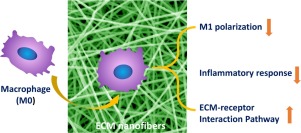Applied Materials Today ( IF 8.3 ) Pub Date : 2019-11-26 , DOI: 10.1016/j.apmt.2019.100508 Rui-Xin Wu 1, 2 , Chi Ma 1 , Yongxi Liang 1 , Fa-Ming Chen 2 , Xiaohua Liu 1

|
An in-depth understanding of biomaterial cues to selectively polarize macrophages is beneficial in the design of “immuno-informed” biomaterials that positively interact with the immune system to dictate a favorable macrophage response following implantation. Given the promising future of ECM-mimicking nanofibrous biomaterials in biomedical application, it is essential to elucidate how their intrinsic cues, especially the nanofibrous architecture, affect macrophages. In the present study, we evaluated how the nanofibrous architecture of a gelatin matrix modulated macrophage responses from the perspectives of cellular behaviors and a transcriptome analysis. In our results, the nanofibrous surface attenuated M1 polarization and down-regulated the inflammatory responses of macrophages compared with a smooth surface. Besides, the cell-material interaction was up-regulated and the adhered macrophages tended to maintain an original, non-polarized state on the nanofibrous matrix. Accordingly, whole transcriptome analysis revealed that nanofibrous architecture up-regulated the pathways related to ECM-receptor interaction and down-regulated pathways related to pro-inflammation. This study provides a panoramic view of the interaction between macrophages and nanofibers, and offers valuable information for the design of immunomodulatory ECM-mimicking biomaterials for tissue regeneration.
中文翻译:

模仿ECM的纳米纤维基质诱使巨噬细胞趋向于抗炎表型:细胞行为和转录组分析。
深入理解选择性极化巨噬细胞的生物材料线索在设计与免疫系统积极相互作用以指示植入后有利的巨噬细胞反应的“免疫知情”生物材料的设计中是有益的。鉴于在生物医学应用中模仿ECM的纳米纤维生物材料的发展前景广阔,必须阐明其内在线索(尤其是纳米纤维结构)如何影响巨噬细胞。在本研究中,我们从细胞行为和转录组分析的角度评估了明胶基质的纳米纤维结构如何调节巨噬细胞反应。在我们的结果中,与光滑表面相比,纳米纤维表面减弱了M1极化并下调了巨噬细胞的炎症反应。除了,细胞-材料相互作用被上调,并且粘附的巨噬细胞倾向于在纳米纤维基质上保持原始的非极化状态。因此,全转录组分析表明,纳米纤维结构上调了与ECM-受体相互作用有关的途径,而下调了与促炎有关的途径。这项研究提供了巨噬细胞和纳米纤维之间相互作用的全景,并为设计用于组织再生的免疫调节ECM模拟生物材料提供了有价值的信息。整个转录组分析表明,纳米纤维结构上调了与ECM-受体相互作用有关的途径,而下调了与促炎有关的途径。这项研究提供了巨噬细胞和纳米纤维之间相互作用的全景,并为设计用于组织再生的免疫调节ECM模拟生物材料提供了有价值的信息。整个转录组分析显示,纳米纤维结构上调了与ECM-受体相互作用有关的途径,而下调了与促炎有关的途径。这项研究提供了巨噬细胞和纳米纤维之间相互作用的全景,并为设计用于组织再生的免疫调节ECM模拟生物材料提供了有价值的信息。


























 京公网安备 11010802027423号
京公网安备 11010802027423号